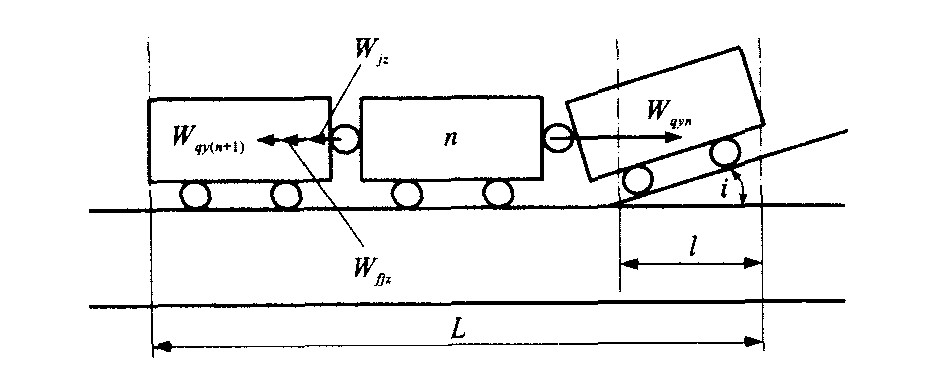-
摘要: 为了优化城市列车牵引计算与运行模拟系统的单质点简化模型, 提高计算准确性, 在快速牵引策略模型的基础上, 构造了城市轨道交通列车牵引计算与仿真的多质点优化模型。将列车模型构造为由多个质点构成的质点链, 考虑了列车长度在附加阻力计算中的影响; 通过工况转换的优化, 合理选择惰行起点以及控制速度波动幅度; 提高中间过程计算精度, 运用反向递推试凑法寻找进站制动起点。多质点模型与单质点模型的计算结果对比表明, 技术速度提高了5%~20%, 总能耗降低了5%~20%, 进站制动初速度降低了5%~25%, 该模型可行。Abstract: In order to optimize the single-particle model of urban mass transit traction calculation system and make traction calculation result more accurate, the optimized multi-particle simulation model was built up. Train was regarded as a dynamic chain made of multiple particles so that every car could be analyzed, train length influence on its adjunctive resistance was considered. Optimization shifting gears, rational selection freewheeling position and control the range of velocity fluctuation were adopted to improve the model calculation veracity, train braking position was searched through reverse recursion method. The computation results of the optimized traction calculation model and single-particle model show that the average velocity is raised by 5%~20%, the start velocity is decreased by 5%~25% in pulling into station process, the energy consumption is decreased by 5%~20%, the model is feasible.
-
表 1 线路数据
Table 1. Lines data
开始位置/m 0 550 724 780 947 1 050 1 290 1 588 1 650 1 755 1 781 1 900 坡段长度/m 550 174 56 167 103 240 298 62 105 26 119 53 坡度/‰ 20.00 -6.80 -6.80 -3.00 -3.00 9.22 3.00 3.00 -3.00 -3.00 -3.00 -23.40 曲线半径/m 直线 直线 500 500 500 直线 直线 400 400 直线 400 400 限速/(km·h-1) 80 80 80 80 80 80 80 80 80 80 80 80 开始位置/m 1 953 2 100 2 263 2 300 2 580 2 950 3 199 3 400 3 499 3 530 3 600 3 670 坡段长度/m 147 163 37 280 370 249 201 99 30 70 70 213 坡度/‰ -23.40 -23.40 -23.40 30.00 3.00 -5.75 -5.75 30.00 30.00 30.00 -3.00 -3.00 曲线半径/m 400 400 直线 直线 直线 直线 350 350 直线 350 350 直线 限速/(km·h-1) 80 80 80 80 80 80 80 80 80 80 80 80 开始位置/m 3 883 3 900 4 133 4 137 4 200 4 340 4 500 4 800 4 855 4 916 5 100 5 315 坡段长度/m 17 233 4 63 140 160 300 55 61 184 215 — 坡度/‰ -3.00 -8.00 -8.00 -5.00 -5.00 10.00 10.85 10.85 10.85 10.85 10.85 — 曲线半径/m 350 350 350 1 000 1 000 直线 直线 直线 2 000 直线 直线 — 限速/(km·h-1) 80 80 80 80 80 80 80 80 80 80 80 — 表 2 车站数据
Table 2. Stations data
车站名称 中心位置/m 停站时间/s a 400.0 1 b 1 394.0 1 c 2 827.0 1 d 3 750.5 1 e 5 222.0 1 注 表 2所示的停站时间并非模拟停站时间, 而是以1表示停站, 0表示不停站。 表 3 列车参数
Table 3. Train parameters

表 4 动车参数
Table 4. Indices of mobile car

表 5 动车特性数据
Table 5. Character data of mobile car

表 6 计算结果比较
Table 6. Comparison of calculation result

-
[1] 石红国, 彭其渊, 郭寒英. 城市轨道交通牵引计算算法[J]. 交通运输工程学报, 2004, 4(3): 30—33. http://transport.chd.edu.cn/article/id/200403008Shi Hong-guo, Peng Qi-yuan, Guo Han-ying. Traction calculation of urban mass transit[J]. Journal of Traffic and Transportation Engineering, 2004, 4(3): 30—33. (in Chinese) http://transport.chd.edu.cn/article/id/200403008 [2] 毛保华, 何天键, 袁振洲, 等. 通用列车运行模拟软件系统研究[J]. 铁道学报, 2000, 22(1): 1—5. https://www.cnki.com.cn/Article/CJFDTOTAL-TDXB200001000.htmMao Bao-hua, He Tian-jian, Yuan Zhen-zhou, et al. Ageneralpurposed simulation systemontrain movement[J]. Journal of the China Railway Society, 2000, 22(1): 1—5. (in Chinese) https://www.cnki.com.cn/Article/CJFDTOTAL-TDXB200001000.htm [3] Cheng Jia-xing, Phil H. A note on the calculation of optimal strategies for the minimization of fuel consumption in the control of trains[J]. Transactions on Automatic Control, 1993, 38(11): 1 730—1 734. doi: 10.1109/9.262051 [4] TB/T1407-1998, 列车牵引计算规程[S]. [5] Cheng J, Davydova Y, Howlett P, et al. Optimal driving strategies for a train journey with non-zero track gradient and speed limits[J]. Journal of Mathematics Applied in Businessand Industry, 1999, 33(10): 89—115. [6] Ho T K, Mao B H, Yuan Z Z, et al. Computer simulation and modelling in railway applications[J]. Computer Physics Communications, 2002, 14(3): 1—10. [7] 何鸿云, 朱金陵. 列车牵引计算及操纵示意图计算机软件的开发[J]. 西南交通大学学报, 2000, 35(5): 514—516. https://www.cnki.com.cn/Article/CJFDTOTAL-XNJT200005016.htmHe Hong-yun, Zhu Jin-ling. Design of software for traction calculation and operation schematic diagram of trains[J]. Journal of Southwest Jiaotong University, 2000, 35(5): 514—516. (in Chinese) https://www.cnki.com.cn/Article/CJFDTOTAL-XNJT200005016.htm [8] 郭佑民, 王志伟, 武福, 等. 列车操纵与运行仿真系统[J]. 兰州铁道学院学报, 2002, 21(6): 125—127. https://www.cnki.com.cn/Article/CJFDTOTAL-LZTX200206034.htmGuo You-min, Wang Zhi-wei, Wu Fu, et al. Train operation and movement simulation system[J]. Journal of Lanzhou Railway University, 2002, 21(6): 125—127. (in Chinese) https://www.cnki.com.cn/Article/CJFDTOTAL-LZTX200206034.htm [9] 冯晓云, 何鸿云, 朱金陵. 列车优化操纵原则及其优化操纵策略的数学描述[J]. 机车电传动, 2001, 30(4): 13—16. https://www.cnki.com.cn/Article/CJFDTOTAL-JCDC200104003.htmFeng Xiao-yun, He Hong-yun, Zhu Jin-ling. Train optimized handling principles and mathematical description on optimized handling strategies[J]. Electric Drive for Locomotives, 2001, 30(4): 13—16. (in Chinese) https://www.cnki.com.cn/Article/CJFDTOTAL-JCDC200104003.htm [10] 李立明, 罗晓峥, 沈祥林. 地铁电动车组交流牵引计算与仿真分析[J]. 机车电传动, 2003, 32(3): 33—34. https://www.cnki.com.cn/Article/CJFDTOTAL-JCDC200303008.htmLi Li-ming, Luo Xiao-zheng, Shen Xiang-lin. Calculation and simulation analysis of AC traction for metro EMUS[J]. Electric Drive for Locomotives, 2003, 32(3): 33—34. (in Chinese) https://www.cnki.com.cn/Article/CJFDTOTAL-JCDC200303008.htm [11] 刘剑锋, 丁勇, 刘海冬, 等. 城市轨道交通多列车运行模拟系统研究[J]. 交通运输系统工程与信息, 2005, 5(1): 79—82. https://www.cnki.com.cn/Article/CJFDTOTAL-YSXT200501014.htmLiu Jian-feng, Ding Yong, Liu Hai-dong, et al. Multitrain movement simulation system for urban rail transit[J]. Journal of Transportation Systems Engineering and Information Technology, 2005, 5(1): 79—82. (in Chinese) https://www.cnki.com.cn/Article/CJFDTOTAL-YSXT200501014.htm -





 下载:
下载:








